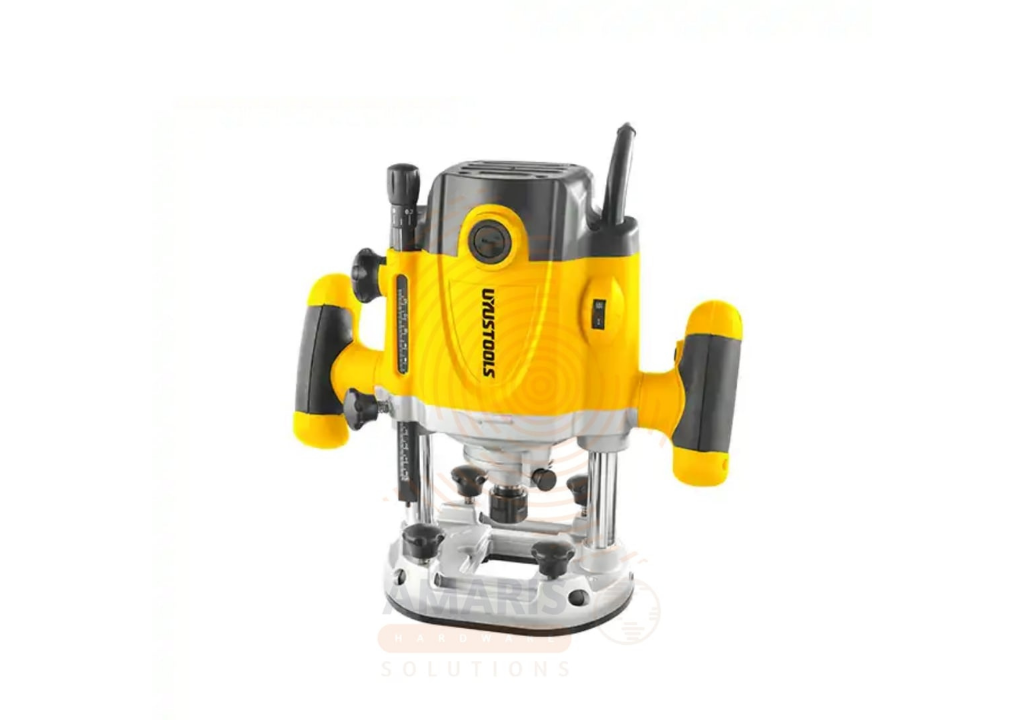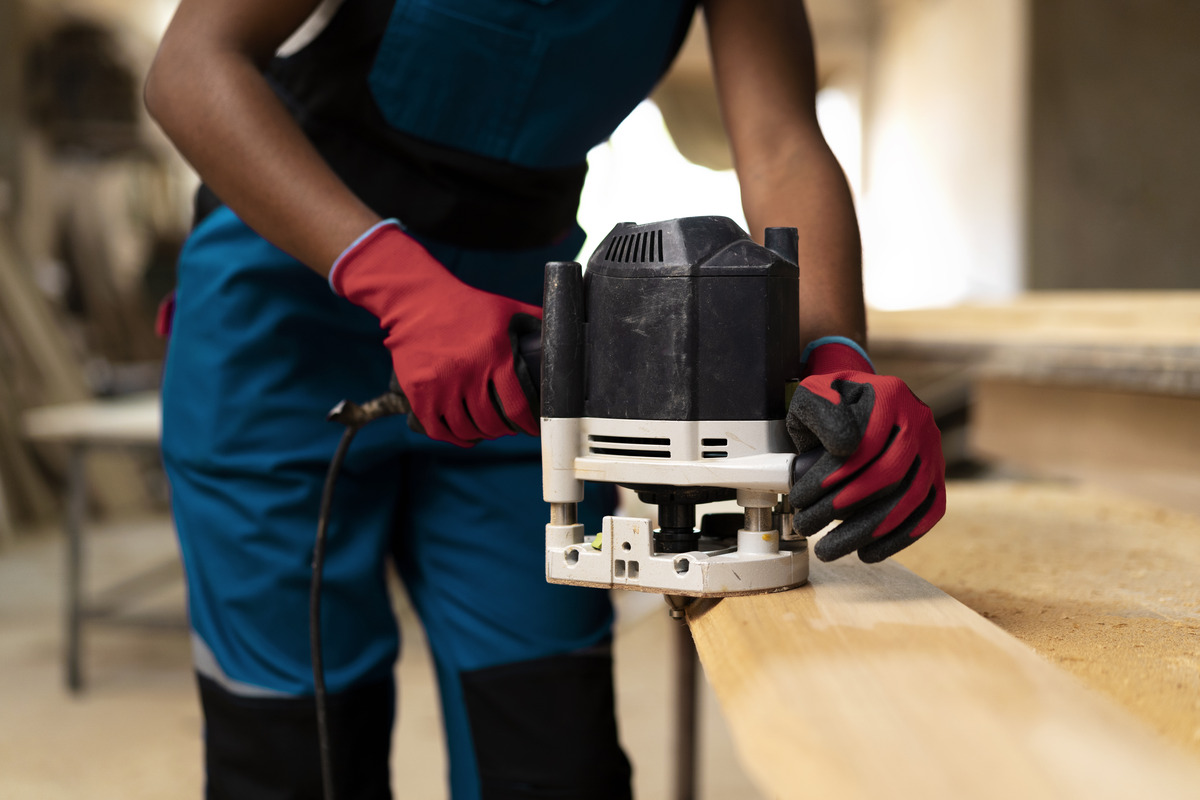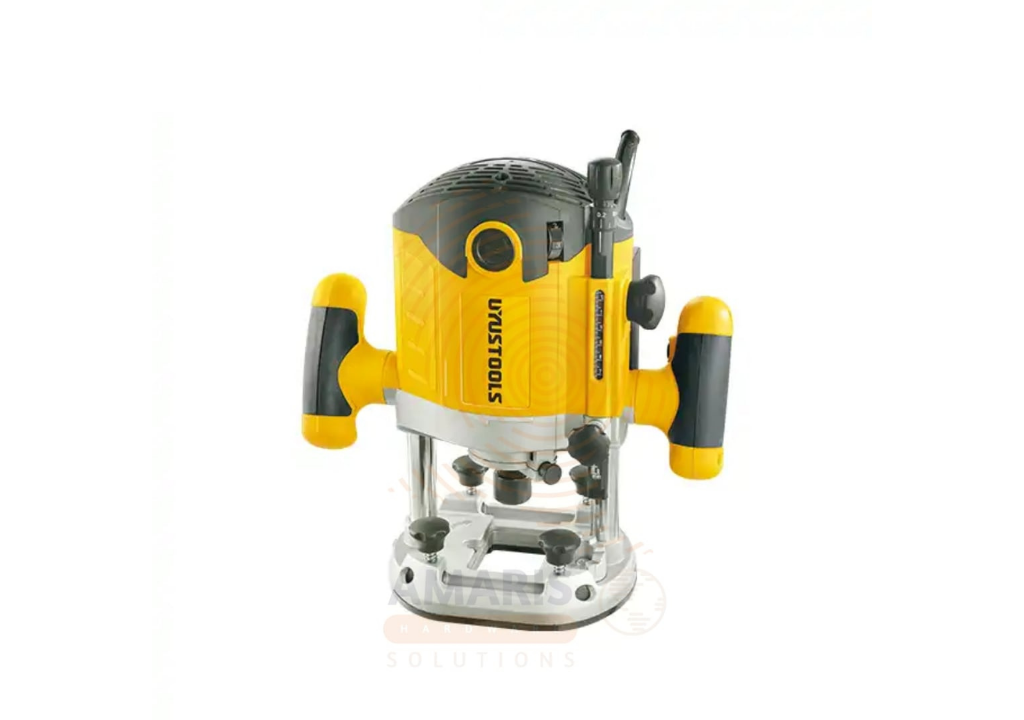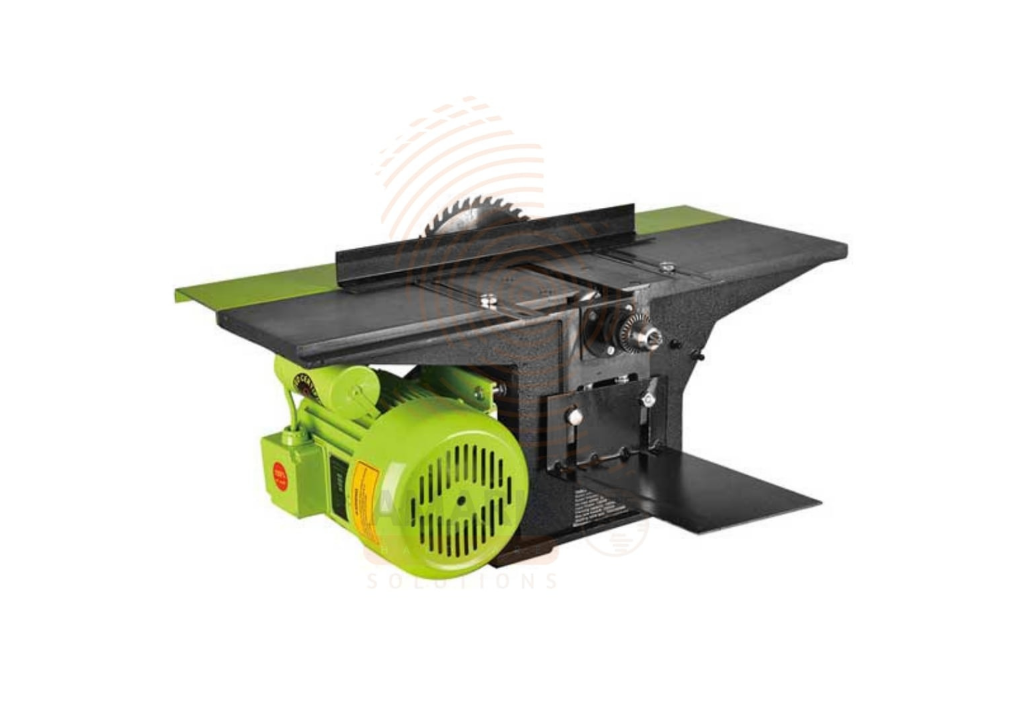“Shaping Creativity: The Power of the Electric Router” 🪚✨🔧

When it comes to woodworking, the electric router is like a magic wand for craftsmen. This powerful, versatile tool can transform plain wooden boards into works of art—whether you’re adding intricate grooves, creating perfect edges, or crafting custom joinery. From home workshops to professional carpentry shops, the electric router stands tall as one of the most loved and most used tools.
If you want clean, precise, and professional-looking woodwork, this is the tool you can’t afford to overlook.
What is an Electric Router? ⚡
An electric router is a motor-powered cutting tool designed to hollow out, trim, and shape materials—most commonly wood. It uses a rotating bit that spins at incredibly high speeds to cut with precision. By simply changing the bit or adjusting the depth, you can use it for a wide range of woodworking applications.
Unlike hand tools, an electric router gives you uniformity, speed, and accuracy—the holy trinity for any woodworker.
Why It’s a Must-Have in Woodworking 🪵
Here’s why carpenters, cabinet makers, and hobbyists swear by it:
- Unmatched Precision – Achieve clean, smooth cuts with minimal finishing work.
- Versatility – Perfect for edging, grooving, trimming, and decorative work.
- Speed – Get more done in less time without sacrificing quality.
- Custom Designs – Add creative patterns and personalized touches to your projects.
- Professional Finish – Makes even DIY projects look like they came from a high-end shop.
Main Types of Electric Routers 🔍
- Fixed Base Router – Ideal for edge shaping and precision cuts where depth doesn’t change mid-pass.
- Plunge Router – Allows you to start cutting in the middle of the wood, great for grooves and mortises.
- Trim Router – Lightweight and perfect for small-scale work or finishing edges.
Many woodworkers eventually own more than one type for maximum flexibility.
Common Uses for an Electric Router 🧰
- Edge Profiling – Create decorative edges on tables, shelves, and frames.
- Grooving – Perfect for cabinet doors, sign making, and paneling.
- Joinery – Make slots and mortises for strong, seamless joints.
- Trimming – Neaten up laminate edges or veneer work.
- Template Routing – Use guides to replicate designs perfectly every time.
How to Use an Electric Router Safely 🦺
While routers are incredibly useful, they’re also powerful and require care:
- Secure the Workpiece – Prevents shifting that could ruin your cut or cause accidents.
- Select the Right Bit – Match it to your project and material.
- Set the Depth Correctly – Too deep and the router may strain; too shallow and the cut may be uneven.
- Work in the Right Direction – Typically, move the router against the bit’s rotation for control.
- Wear Safety Gear – Eye protection, hearing protection, and dust masks are a must.
Features to Look For in a Good Electric Router 🔩
- Variable Speed Control – Adjust for different materials and bit sizes.
- Soft Start Motor – Reduces torque at startup for smoother handling.
- Easy Depth Adjustment – Quick and precise settings for repeat cuts.
- Ergonomic Grip – Comfort matters, especially for long sessions.
- Sturdy Base Plate – Ensures stability for accurate results.
Maintenance Tips for Longevity 🛠️
- Clean the Router Regularly – Sawdust buildup can affect performance.
- Check the Collet – Ensure bits are securely fastened before each use.
- Lubricate Moving Parts – Keeps adjustments smooth and accurate.
- Store Properly – Keep it in a dry, dust-free place.
Why Woodworkers Love It 💡
An electric router turns good carpentry into great carpentry. Whether you’re a pro making high-end cabinetry or a DIYer adding decorative trims to furniture, it gives your work that crisp, professional edge.
At Amaris Hardware Solutions, we’ve seen countless customers elevate their projects the moment they start using a router. It’s not just about cutting wood—it’s about unlocking your creativity and making ideas come to life with precision and style.


 Acrylic Sealants
Acrylic Sealants Construction Adhesives
Construction Adhesives Double-Sided Tape
Double-Sided Tape Duct Tape
Duct Tape Electrical Tape
Electrical Tape Epoxy & Resins
Epoxy & Resins Masking Tape
Masking Tape
 Automotive Wrenches & Socket Sets
Automotive Wrenches & Socket Sets Battery Chargers & Jump Starters
Battery Chargers & Jump Starters Car Jacks & Stands
Car Jacks & Stands Car Wash & Detailing Products
Car Wash & Detailing Products Diagnostic Tools
Diagnostic Tools Tire Inflators
Tire Inflators Vehicle Lighting
Vehicle Lighting Oil & Lubricants
Oil & Lubricants
 Adhesives & Sealants
Adhesives & Sealants Bricks & Blocks
Bricks & Blocks Cement & Concrete
Cement & Concrete Drywall & Plaster
Drywall & Plaster Flooring (Tiles, Wood, Laminate)
Flooring (Tiles, Wood, Laminate) Lumber & Plywood
Lumber & Plywood Paints, Primers & Coatings
Paints, Primers & Coatings Insulation Materials
Insulation Materials Roofing Materials
Roofing Materials
 Circuit Breakers
Circuit Breakers Electrical Cables & Wires
Electrical Cables & Wires Switches & Sockets
Switches & Sockets Fuses & Relays
Fuses & Relays Connectors & Terminals
Connectors & Terminals Electrical Boxes & Panels
Electrical Boxes & Panels Conduit & Fittings
Conduit & Fittings Lighting Fixtures & Bulbs
Lighting Fixtures & Bulbs Extension Cords & Power Strips
Extension Cords & Power Strips
 Anchors
Anchors Bolts
Bolts Clips & Clamps
Clips & Clamps Screws
Screws Nuts
Nuts Washers
Washers Rivets
Rivets Nails
Nails Threaded Rods
Threaded Rods
 Hammers
Hammers Measuring Tools (Tapes, Levels, Calipers)
Measuring Tools (Tapes, Levels, Calipers) Screwdrivers
Screwdrivers Pliers & Cutters
Pliers & Cutters Saws & Blades
Saws & Blades Chisels & Punches
Chisels & Punches Allen Keys & Hex Keys
Allen Keys & Hex Keys Ratchets & Socket Sets
Ratchets & Socket Sets Wrenches & Spanners
Wrenches & Spanners
 Power Tool Accessories (Blades, Bits, Discs)
Power Tool Accessories (Blades, Bits, Discs) Rotary Tools
Rotary Tools Saws (Circular, Jigsaw, Reciprocating)
Saws (Circular, Jigsaw, Reciprocating) Drills & Drivers
Drills & Drivers Grinders & Sanders
Grinders & Sanders Heat Guns
Heat Guns Nail Guns
Nail Guns Impact Wrenches
Impact Wrenches Batteries & Chargers
Batteries & Chargers
 Pipes & Fittings (PVC, Copper, PEX)
Pipes & Fittings (PVC, Copper, PEX) Plumbing Tools
Plumbing Tools Pumps & Motors
Pumps & Motors Sealants & Adhesives for Plumbing
Sealants & Adhesives for Plumbing Valves & Taps
Valves & Taps Water Heaters
Water Heaters Drainage Systems
Drainage Systems Faucets & Fixtures
Faucets & Fixtures Hoses & Tubing
Hoses & Tubing
 Hinges & Latches
Hinges & Latches Hooks & Brackets
Hooks & Brackets Window Hardware
Window Hardware Chains & Cables
Chains & Cables Casters & Wheels
Casters & Wheels Shelving & Storage Systems
Shelving & Storage Systems Door Handles & Locks
Door Handles & Locks Drawer Slides & Cabinet Hardware
Drawer Slides & Cabinet Hardware
 Personal Protective Equipment (PPE)
Personal Protective Equipment (PPE) Respirators & Masks
Respirators & Masks Safety Glasses
Safety Glasses Safes
Safes Security Cameras
Security Cameras Gloves
Gloves Helmets
Helmets Ear Protection
Ear Protection Fire Safety Equipment
Fire Safety Equipment Locks & Padlocks
Locks & Padlocks Motion Sensors & Alarms
Motion Sensors & Alarms
 Garden Fencing
Garden Fencing Garden Furniture Hardware
Garden Furniture Hardware Lawn Mowers
Lawn Mowers Trimmers & Edgers
Trimmers & Edgers Shovels & Spades
Shovels & Spades Rakes & Hoes
Rakes & Hoes Pruning Shears & Loppers
Pruning Shears & Loppers Watering Systems (Hoses, Sprinklers, Nozzles)
Watering Systems (Hoses, Sprinklers, Nozzles)
 Interior Paints
Interior Paints Paint Brushes & Rollers
Paint Brushes & Rollers Paint Strippers & Thinners
Paint Strippers & Thinners Paint Trays & Accessories
Paint Trays & Accessories Exterior Paints
Exterior Paints Spray Paints
Spray Paints Primers & Undercoats
Primers & Undercoats Varnishes & Stains
Varnishes & Stains
 Gaskets & Seals
Gaskets & Seals Hydraulic Fittings
Hydraulic Fittings Industrial Fasteners
Industrial Fasteners Industrial Hoses
Industrial Hoses Lubricants & Greases
Lubricants & Greases Metal Sheets & Bars
Metal Sheets & Bars Bearings & Bushings
Bearings & Bushings Belts & Pulleys
Belts & Pulleys
 HVAC Filters
HVAC Filters Insulation for HVAC
Insulation for HVAC Air Conditioners
Air Conditioners Refrigerants
Refrigerants Ventilation Ducts & Fittings
Ventilation Ducts & Fittings Thermostats & Controllers
Thermostats & Controllers Fans & Blowers
Fans & Blowers
 Pegboards & Hooks
Pegboards & Hooks Shelving Units
Shelving Units Storage Bins & Containers
Storage Bins & Containers Toolboxes & Tool Chests
Toolboxes & Tool Chests Workbenches
Workbenches Drawer Organizers
Drawer Organizers Labeling Supplies
Labeling Supplies
 Welding Accessories (Clamps, Brushes)
Welding Accessories (Clamps, Brushes) Welding Electrodes & Rods
Welding Electrodes & Rods Welding Helmets & Gloves
Welding Helmets & Gloves Welding Machines
Welding Machines Soldering Irons & Stations
Soldering Irons & Stations Flux & Solder Wire
Flux & Solder Wire
 Generator Accessories
Generator Accessories Inverters
Inverters Portable Generators
Portable Generators Power Inverters
Power Inverters Transfer Switches
Transfer Switches Diesel & Gasoline Generators
Diesel & Gasoline Generators
 Transport Equipment: Carts, Dollies, and Hand Trucks
Transport Equipment: Carts, Dollies, and Hand Trucks Storage Solutions: Pallets, Racks, and Containers
Storage Solutions: Pallets, Racks, and Containers Lifting Equipment: Hoists, Cranes, and Jacks
Lifting Equipment: Hoists, Cranes, and Jacks Conveyors and Accessories: Belts and Rollers
Conveyors and Accessories: Belts and Rollers





